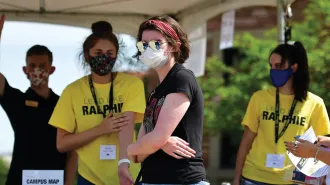Search Results
Counting on COVID-19 vaccines
Students will answer questions about the online Science News article “Global inequity in COVID-19 vaccination is more than a moral problem,” which explores the scientific and economic impacts of the failure to fairly distribute vaccines globally. A version of the story, “Vaccine inequity will prolong pandemic,” appears in the March 27, 2021 issue of Science News.
Planning ahead to prevent future disasters
Students will take on the role of a planning board for a region identified as having an increased risk for natural hazards — wildfires, floods, droughts, heatwaves or hurricanes — due to climate change. After proposing regulations and other strategies to reduce the natural hazard’s impact, the students will discuss the merits of the proposed solutions before voting on a disaster plan and budget for their region.

Our Brains, Our Futures
In this guide, students will explore how brain science has progressed over the last century and how that progress could inform the field’s future. Then, students will discuss the ethics of advancements in neurotechnology.
Neuroscience fiction and fact
Students will answer questions about the online Science News article “Three visions of the future, inspired by neuroscience’s past and present,” which explores how advances in the field of neuroscience are bringing scientists closer to expanding, linking and healing human brains. A version of the story, “Our brains, our futures,” can be found in the March 13, 2021 issue of Science News.
Building better brains?
Students will explore advances in neurotechnology by making connections between examples they’ve seen in popular culture and what is currently possible. Students will then think critically about positive and negative effects of advancements in this area of science.

COVID-19 On Campus
In this guide, students will learn about strategies that five universities used to monitor coronavirus cases on campuses, analyze the strategies’ effectiveness at minimizing spread and reflect on the strategies used at their own school.
COVID-19 lessons for colleges
Students will explore and analyze various approaches some universities have taken to manage the COVID-19 pandemic on their campuses before comparing the strategies to those used at their own school.
COVID-19 goes to college
Students will answer questions about the online Science News article “How 5 universities tried to handle COVID-19 on campus,” which explores five universities’ strategies for monitoring and stemming the spread of the coronavirus on campuses. A version of the story, “COVID-19 on campus,” appears in the February 27, 2021 issue of Science News.
Building better boxes based on beetles
In this activity, students will learn about the seemingly indestructible diabolical ironclad beetle and review Newton’s laws of motion and force diagrams. Then, students will design, build and test crush-resistant packaging using biomimetics, the practice of solving problems using solutions inspired by biological structures and systems.

Earth’s Oceans Broke Heat Records in 2020
In this guide, students will learn about how the amount of heat energy that Earth’s upper oceans have absorbed has increased over time. Then, students will discuss strategies for interpreting, understanding and communicating data.
In hot water
Students will answer questions about the online Science News article “Earth’s oceans are storing record-breaking amounts of heat,” which explores how the upper oceans’ heat storage capacity has changed over time. A version of the story, “Earth’s oceans broke heat records in 2020,” appears in the February 13, 2021 issue of Science News.
Communicating data
Students will discuss how graphs and quantitative analogies are useful for interpreting and understanding data. Then, students will analyze and compare how effective each strategy is at communicating a scientific claim. As an extension, students may propose an alternative method of displaying or explaining given data.